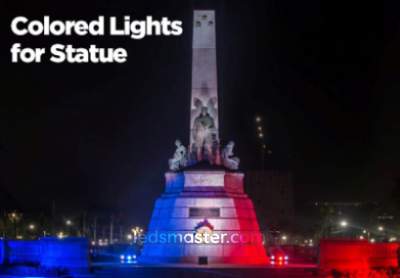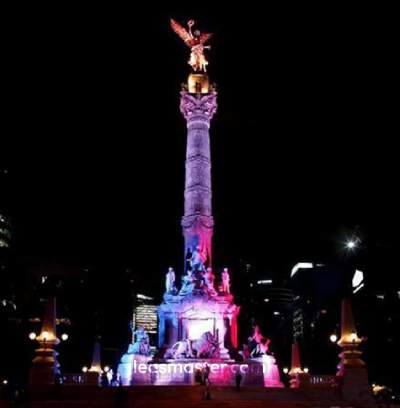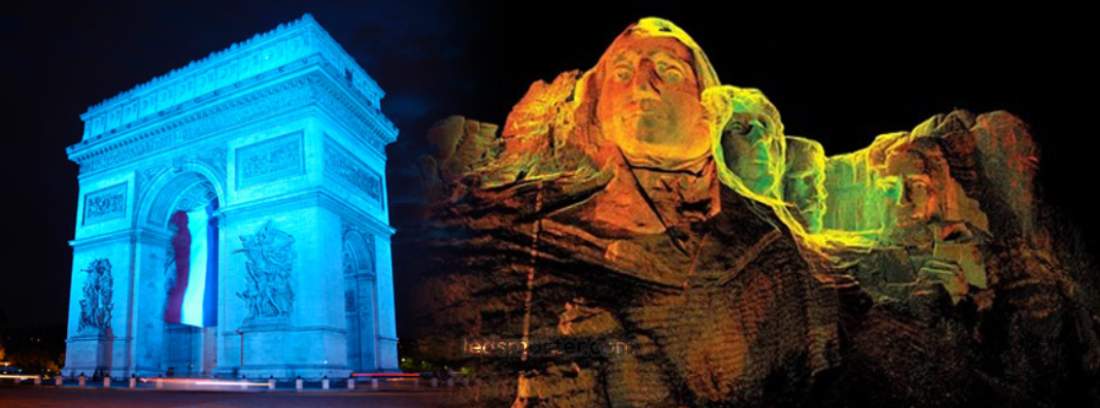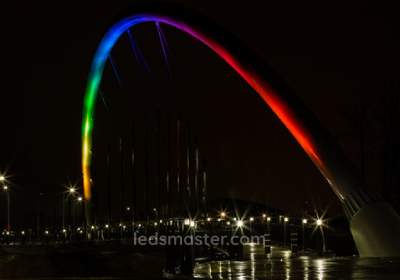Imagine a city at night where iconic monuments come alive with mesmerizing light and shadow. The torch of the Statue of Liberty glows warmly, the Arc de Triomphe is bathed in regal hues, and the heads of Mount Rushmore stand out in stunning detail. Our advanced monument lighting solutions make these captivating visuals possible, transforming nighttime landscapes into breathtaking scenes that celebrate art and history. Whether it’s a soft glow or dynamic color changes, our products bring monuments to life, inviting admiration and reflection.
Illuminating elements such as statues or monuments at night can effectively draw attention to them. By using captivating outdoor wall washer lighting, you can create a visually appealing effect. Traditional landscape lighting fixtures like metal halide, halogen, and high-pressure sodium lamps are energy-intensive and struggle to produce colored lights. Switching to RGB LEDs is a wise choice, as they offer a wide range of beam angles and color options to enhance the tower’s appearance. A well-thought-out lighting design is a respectful way to honor the memorial.
Get your complimentary lighting design today
Here are a few tips to help you achieve the best results for monument lighting. First, let’s examine how to properly illuminate a statue.
Table of Contents
ToggleWhen lighting a monument or statue, it’s essential to consider both the aesthetic and practical aspects. The goal is to enhance the monument’s features while ensuring the lighting is appropriate for its setting. Factors such as the monument’s size, material, and surrounding environment should all influence your lighting choices.
 Choosing the right colors for monument lighting can significantly impact its visual appeal. LED lights are capable of emitting almost all colors, but selecting the appropriate colors requires careful consideration. According to the Monument Lighting Scheme at UTSA, soft white and orange lights are suitable for general purposes, offering a warm and inviting glow. For monuments representing athletic achievements, using blue and orange colors can evoke feelings of energy and vigor.
Choosing the right colors for monument lighting can significantly impact its visual appeal. LED lights are capable of emitting almost all colors, but selecting the appropriate colors requires careful consideration. According to the Monument Lighting Scheme at UTSA, soft white and orange lights are suitable for general purposes, offering a warm and inviting glow. For monuments representing athletic achievements, using blue and orange colors can evoke feelings of energy and vigor.
If you want to create a stunning color-changing wall washer effect on the sculpture, consider using RGB lights with DMX control. This system allows you to design your own color patterns, offering endless possibilities for dynamic lighting displays. If you need more information about the lighting system, including how to manipulate the color sequence, please feel free to contact us using our form.
 Light pollution is a growing concern, as excessive light at night can interfere with human biological functions, such as the production of melatonin, a hormone that regulates sleep. To minimize light pollution, it is crucial to illuminate only the areas that require lighting.
Light pollution is a growing concern, as excessive light at night can interfere with human biological functions, such as the production of melatonin, a hormone that regulates sleep. To minimize light pollution, it is crucial to illuminate only the areas that require lighting.
Choosing LED lighting fixtures with reduced glare can help reduce pollution caused by direct light. Ensure that the lights have quality lenses and shielding to prevent light leakage. Proper arrangement of the luminaires is also essential. Before installation, inspect the monument’s surface to determine if it is reflective. If the material is reflective, avoid using excessively bright lights. The color temperature should ideally be between 3000 to 3500K, as this range is less likely to cause discomfort to the human eye.
For outdoor LED lighting fixtures, durability is key. The lights must withstand adverse weather conditions, such as heavy rain, snowstorms, strong winds, and extreme temperature fluctuations between day and night. Our LED lights for monuments are designed with an IP66 waterproof rating, ensuring they provide reliable protection in various climates, including the challenging weather conditions found in London and Russia.
Additionally, it is advisable to use lighting fixtures that support 12V to 24V operation. This lower voltage range reduces the risk of electric shock, enhancing safety.
After understanding these considerations, let’s explore some additional tips to provide the best lighting solutions for monuments.

When designing monument lighting, it’s essential to highlight the statue’s most distinctive features. Select one or two key characteristics that you want to emphasize to the audience. For instance, the torch of the Statue of Liberty, the arches of the Arc de Triomphe, or the heads of the Mount Rushmore National Memorial are iconic elements that can draw significant attention when illuminated. Using a narrow beam angle (approximately 25°) to light these specific areas creates a focal point that captures the audience’s gaze.
To enhance these features effectively, position the lights to cast shadows that emphasize the texture and depth of the prominent features. Varying light intensities can create a dynamic visual effect, drawing attention to the most important aspects of the monument. Additionally, choosing colors that complement the material and historical significance of the statue can add a layer of meaning to the lighting design.
 Creating a three-dimensional effect through lighting can significantly enhance the visual impact of a monument. To achieve this, the lighting arrangement should be designed according to the monument’s shape and size. For example, producing a color gradient effect for the Washington Monument or the Gateway Arch can be achieved by using a combination of different beam angles.
Creating a three-dimensional effect through lighting can significantly enhance the visual impact of a monument. To achieve this, the lighting arrangement should be designed according to the monument’s shape and size. For example, producing a color gradient effect for the Washington Monument or the Gateway Arch can be achieved by using a combination of different beam angles.
A gradient lighting effect can be created by using larger beam angles for the base regions of the monument and smaller beam angles for the upper or distal regions. This technique adds depth and dimension to the monument. Connecting RGB wall washer lights to a DMX-512 device allows for the production of mesmerizing 3D color sequences, offering precise control over color changes and transitions for a dynamic lighting display.
Layered lighting can also be implemented to accentuate different parts of the monument, enhancing the overall three-dimensional appearance. For instance, when lighting the Washington Monument, broad beam angles can be used to floodlight the base, creating a strong foundation of light. Medium beam angles can be applied to illuminate the middle section, blending the light from the base and the top. Narrow beam angles can be utilized to highlight the peak, ensuring a smooth transition of light across the entire monument.
By emphasizing prominent characteristics and creating a three-dimensional effect, you can enhance the visual impact and honor the monument’s historical and cultural significance. Utilizing advanced lighting techniques and technology, such as RGB wall washers and DMX control, allows for dynamic and respectful illumination that captivates audiences while minimizing light pollution. Through these considerations, you can achieve a stunning and meaningful lighting display that brings monuments to life after dark.